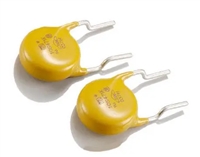2.2 OUTPUT FEATURES
Table 2-1 OPT Strap Options
These devices are designed for maximum flexibility and can
accommodate most popular sensing requirements via option
pins.
OPT1
Gnd
Vdd
OPT2
Max On-Duration
Vdd
10s
60s
DC Out
DC Out
Toggle
DC Out
Gnd
Vdd
OPT1 and OPT2 inputs control the output mode and Max
On-Duration settings;
Vdd
10s
OC controls the output drive type;
Gnd
Gnd
infinite
AKS controls the use of Adjacent Key Suppression.
All option pins are read by the IC once each complete
acquisition cycle and can be changed during operation.
e.g. batteries. Detection ‘stiction’, the opposite effect, can
occur if a load is shed when an Out pin is active.
OPT1 and OPT2 modes are shown in Table 2-1. These OPT
pins affect all sensing channels.
2.3 AKS™ - ADJACENT KEY SUPPRESSION
These devices feature patent-pending Adjacent Key
2.2.1 DC MODE
O
UTPUTS
Suppression for use in applications where keys are tightly
spaced. If keys are very close and a large finger touches one
key, adjacent keys might also activate. AKS stops such false
detections by comparing relative signal levels among
channels and choosing the channel with the largest signal.
Outputs can respond in a DC mode, where they are active
upon a confirmed detection. An output will remain active for
the duration of the detection, or until the ‘Max On-Duration’
expires (if not infinite), whichever occurs first. If a Max
On-Duration timeout occurs first, the sensor performs a full
recalibration and the output becomes inactive until the next
detection.
The AKS feature can be disabled via the AKS pin:
AKS=0: Disabled; AKS=1: Enabled
The AKS in these parts is a ‘global’ in nature, meaning that
the signal of each key is compared with all other keys, and
only the key with the strongest signal among all keys will
survive initial detection. The word ‘Adjacent’ therefore should
be taken liberally, as a particular key number can be
physically near any other key number and the AKS feature
will operate correctly.
2.2.2 TOGGLE
M
ODE
O
UTPUTS
This mode makes the sensor respond in an on/off flip-flop
mode. It is useful for controlling power loads, for example in
kitchen appliances, power tools, light switches, etc. or
wherever a ‘touch-on / touch-off’ effect is required.
Max On-Duration in Toggle mode is fixed at 10 seconds.
When a timeout occurs, the sensor recalibrates but leaves
the output state unchanged.
When a touch is detected on a key, but just before the
corresponding OUT pin is activated, a check is made for a
pending or current detection on the other keys. If any other
key is active, or if a signal of greater strength is found on any
other key, the key detection is suppressed. Once the active
key(s) are released, a pending key is free to detect.
2.2.3 OUTPUT
D
RIVE; OC OPTION
P
The OC pin controls the output drive type.
IN
OC=0: When tied low, the output is ‘push-pull’, i.e. ‘normal’.
In this mode, the OUT pins are active-high and can source
1mA and sink 5mA of non-inductive current.
Drift compensation also ceases for any key which has been
suppressed, provided its signal exceeds its threshold level
(Figure 2-1).
OC=1: When tied high, the output is ‘open drain’ or ‘open
collector’, i.e. There is no internal pullup device in this mode;
OUT pins are active-low and can sink 5mA of non-inductive
current.
AKS is also very effective on water films which bridge over
adjacent keys. When touching one key a water film will
‘transport’ the touch to the adjacent keys covered by the
same film. These side keys will receive less signal strength
than the key actually being touched, and so they will be
suppressed even if the signal they are detecting is large
enough to otherwise cause an output.
If inductive loads are used, such as small relays, the
inductances should be diode clamped to prevent damage.
When set to operate in a proximity mode (at high gain)
output pin currents should be limited to 1mA to prevent gain
shifting side effects from occurring, which happens when the
load current creates voltage drops on the die and bonding
wires; these small shifts can materially influence the signal
level to cause detection instability as described below.
The downside of ‘global’ AKS is that it is not possible to have
more than one key active at a time.
When two or more devices are synchronized together and all
are using AKS mode, the AKS feature does not extend
beyond each chip. Therefore, in multi-chip configurations it is
possible to use AKS on all keys but still permit 2 or more
keys to detect at the same time.
Care should be taken when the IC and the loads are both
powered from the same supply, and the supply is minimally
regulated. These devices derive their internal references
from the power supply, and sensitivity shifts can occur with
changes in Vdd, as happens when loads are switched on.
This can induce detection ‘cycling’, whereby an object is
detected, the load is turned on, the supply sags, the
detection is no longer sensed, the load is turned off, the
supply rises and the object is reacquired, ad infinitum. To
prevent this occurrence, the Out pins should only be lightly
loaded if the device is operated from an unregulated supply,
2.4 SYNCHRONIZATION
Adjacent capacitive sensors that operate independently can
cross-interfere with each other in ways that will create
sensitivity shifts and spurious detections. Because
Quantum’s QT devices operate in burst mode as opposed to
continuous mode, the opportunity exists to solve this problem
by using time-sequencing of the sensing channels so that
physically adjacent channels do not sense within the same
lQ
7
QT140/150 1.01/1102






 PCF8574资料解读:主要参数分析、引脚说明
PCF8574资料解读:主要参数分析、引脚说明

 AD637数据手册解读:主要特性、引脚及其功能解读、电气参数
AD637数据手册解读:主要特性、引脚及其功能解读、电气参数

 ADUM1201资料手册解读:参数分析、引脚说明、应用分析
ADUM1201资料手册解读:参数分析、引脚说明、应用分析

 一文带你了解压敏电阻器在直流电路中的过压保护作用
一文带你了解压敏电阻器在直流电路中的过压保护作用
